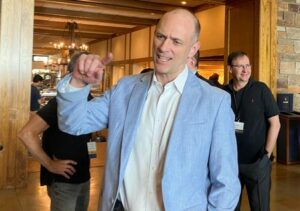(Reuters) – The Federal Reserve has made significant inroads in its battle to bring inflation down to its 2% target, and attention will turn to how long to keep interest rates at their current level if that progress continues, Chicago Fed President Austan Goolsbee said on Tuesday.
“Over the next couple of months, we might equal the fastest drop in inflation in the last century,” Goolsbee said in an interview with broadcaster CNBC. “So we’re making progress on the inflation rate.
“And as long as we’re making progress, as I’ve been saying for a while, the moment of arguing how high should the (policy) rate go is going to fade to how long should we keep rates at this level as inflation is coming down.”
The U.S. central bank last week kept its benchmark overnight interest rate unchanged in the 5.25%-5.50% range but kept the door ajar to raising borrowing costs further to get inflation back down to its target amid a resilient economy.
The Chicago Fed chief also reiterated that he continues to see a “golden path” by which he and his fellow policymakers guide inflation down without causing a recession, and said that recent high levels in yields on long-term Treasury notes, if due to term premium, would need to be factored into the central bank’s assessment of the economic outlook.
The term premium is the added compensation investors expect for owning longer-term debt and is measured using financial models. Its rise was cited last month by Dallas Fed President Lorie Logan as a reason why the Fed may have less need to raise rates. Higher yields and more broadly tightening financial conditions help the Fed by tamping down growth and cooling inflation.
“If the long rates are sustained at high levels, that is most likely tightening and it depends partly on why the rates are going up. If that’s coming from term premium and it’s tightening, then we have got to take that into account,” Goolsbee said. “We should expect to see that with a lag working its way through the economy. So we’re all paying attention and trying to figure out what the driver is.”
(Reporting by Lindsay Dunsmuir; Editing by Andrew Cawthorne and Paul Simao)




